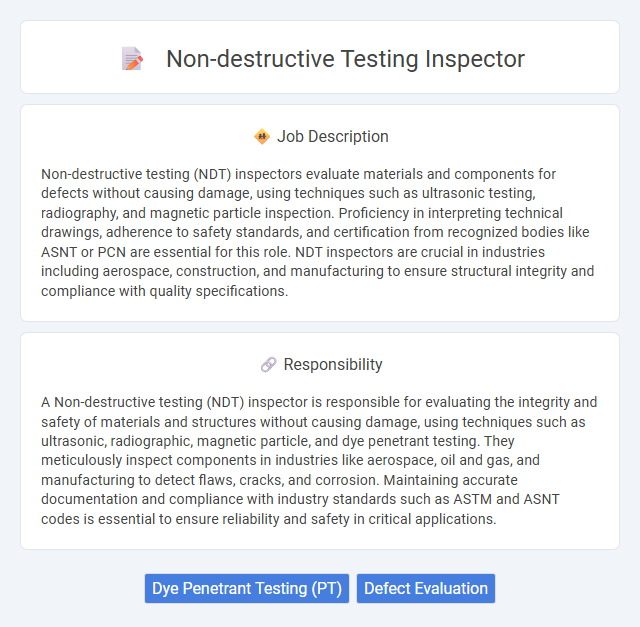
Non-destructive testing (NDT) inspectors evaluate materials and components for defects without causing damage, using techniques such as ultrasonic testing, radiography, and magnetic particle inspection. Proficiency in interpreting technical drawings, adherence to safety standards, and certification from recognized bodies like ASNT or PCN are essential for this role. NDT inspectors are crucial in industries including aerospace, construction, and manufacturing to ensure structural integrity and compliance with quality specifications.
Candidates with strong attention to detail and the ability to remain focused for extended periods are likely to be suitable for a non-destructive testing inspector role. Individuals comfortable working in industrial environments and possessing good hand-eye coordination may adapt well to the physical and technical demands of the job. Those prone to high stress or with limited patience might find this position challenging due to the precision and thoroughness required for accurate inspections.
Qualification
A Non-destructive Testing (NDT) Inspector must hold certifications such as ASNT Level II or Level III in methods like Ultrasonic Testing (UT), Radiographic Testing (RT), Magnetic Particle Testing (MT), or Eddy Current Testing (ET). Essential qualifications include a deep understanding of material properties, flaw detection techniques, and compliance with industry standards like ASTM, API, or ISO. Experience with NDT equipment calibration and interpretation of test results is critical to ensure the structural integrity and safety of components in sectors like aerospace, oil and gas, and manufacturing.
Responsibility
A Non-destructive testing (NDT) inspector is responsible for evaluating the integrity and safety of materials and structures without causing damage, using techniques such as ultrasonic, radiographic, magnetic particle, and dye penetrant testing. They meticulously inspect components in industries like aerospace, oil and gas, and manufacturing to detect flaws, cracks, and corrosion. Maintaining accurate documentation and compliance with industry standards such as ASTM and ASNT codes is essential to ensure reliability and safety in critical applications.
Benefit
Non-destructive testing inspectors likely experience significant career benefits such as enhanced job security due to the high demand for quality control across industries like aerospace, manufacturing, and construction. The role probably offers opportunities for continuous skill development and certification, which may lead to higher earning potential and career advancement. Working in this field could also provide job satisfaction by contributing to safety and reliability without causing damage to tested materials.
Challenge
Non-destructive testing inspectors likely face challenges related to accurately detecting material flaws without causing damage, requiring meticulous attention to detail and advanced technical skills. The probability of encountering complex and varying testing environments may demand adaptability and continuous learning to stay updated with evolving technologies. Inconsistent inspection conditions could increase the difficulty in maintaining precise and reliable results, emphasizing the importance of thorough training and experience.
Career Advancement
Non-destructive testing (NDT) inspectors have significant career advancement opportunities through certification levels such as Level I, II, and III, which enhance their expertise in ultrasonic, radiographic, and magnetic particle testing techniques. Gaining advanced certifications from recognized bodies like ASNT or PCN enables inspectors to qualify for senior roles, supervisory positions, or specialized fields such as aerospace and nuclear industries. Continuous skill development and proficiency in emerging NDT technologies also increase employability and open pathways to managerial and consulting careers.
Key Terms
Dye Penetrant Testing (PT)
Non-destructive testing inspectors specializing in Dye Penetrant Testing (PT) apply visible or fluorescent dyes to detect surface-breaking defects in materials without causing damage. They meticulously prepare surfaces, apply penetrants, remove excess dye, and use developers to reveal cracks, porosity, or other discontinuities critical in aerospace, automotive, and manufacturing industries. Expertise in interpreting PT results ensures structural integrity and compliance with industry standards such as ASTM E165 and ISO 3452.
Defect Evaluation
Non-destructive testing inspectors specialize in the defect evaluation of materials and components using techniques such as ultrasonic testing, radiographic testing, and magnetic particle inspection to identify flaws without compromising structural integrity. They interpret inspection data to assess the size, type, and location of defects, ensuring compliance with industry standards and safety regulations. Expertise in defect evaluation is critical for preventing failures in aerospace, oil and gas, manufacturing, and construction industries.
 kuljobs.com
kuljobs.com